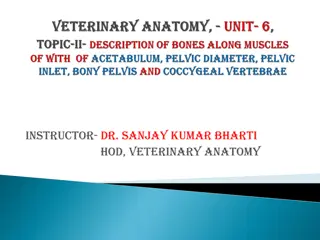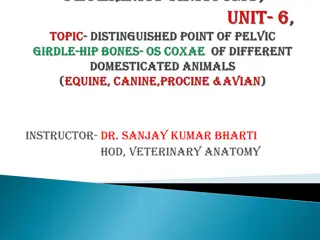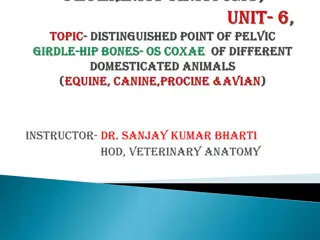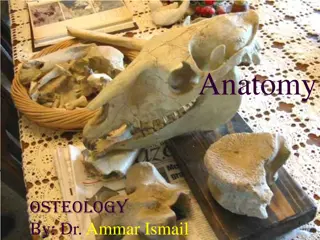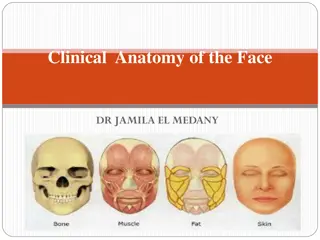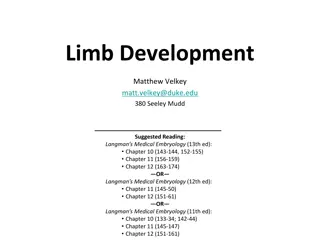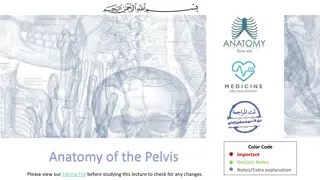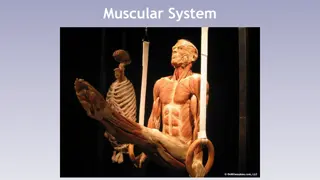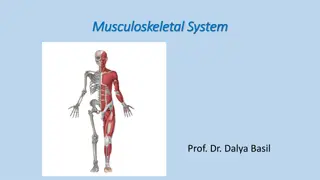Understanding Pelvic Limb Anatomy: Bones and Muscles Overview
Bones and muscles of the pelvic limb, including the pelvis, thigh, leg, and foot, are detailed in this informative content. It covers the general designations of pelvic bones, descriptions of bones along with muscle attachments in various animals, and specifics about the hip bone structure and formation. The content delves into the unique characteristics and functions of the ilium, ischium, and pubis, as well as their roles in forming the hip joint and bony pelvis.
Download Presentation

Please find below an Image/Link to download the presentation.
The content on the website is provided AS IS for your information and personal use only. It may not be sold, licensed, or shared on other websites without obtaining consent from the author. Download presentation by click this link. If you encounter any issues during the download, it is possible that the publisher has removed the file from their server.
E N D
Presentation Transcript
Instructor- DR. SANJAY KUMAR BHARTI HOD, VETERINARY ANATOMY
The general designations for the different parts of the pelvic limb and bones present given below. Pelvic girdle and hip region : Ilium, ischium, and pubis Thigh : Femur Leg : Tibia & fibula Pes : Consisting of Tarsus: A number of small bones called tarsals arranged in the domestic mammals in three rows. Metatarsus: Typically consisting of five bones designated only by numbers 1 to 5, but showing considerable modifications in different animals. Digits: These form the terminal parts of the limbs and usually correspond to the number of the fully developed Each digit is composed of a number of bones arranged serially called the phalanges. The number of phalanges may vary (from 1 to 5) within the species and also in different digits of the same species.
Details Description of Bones along muscles of with of Pelvic Girdle Ilium, Ischium, and Pubis of Ox, Buffalo, Sheep, Goat, Horse, Pig, Dog and Fowl. Muscular attachment of Ilium, Ischium, and Pubis of Ox, Buffalo, Sheep, Goat, Horse, Pig, Dog and Fowl.
The os coxae or hip bone consists of three flat bones, ilium, ischium and pubis, which fuse together to form the acetabulum. Acetabulum- Which is for accommodation of head of femur and forms a joint, i.e- Known as Hip Joint The ilium extends from acetabulum upwards forming the lateral wall of the pelvic cavity.
The pubis and ischium extend medially and backward respectively and their medial borders fuse with those of the opposite side to form the pelvic / ischio-pubic symphysis. The pubis and ischium form the anterior and posterior parts respectively of the floor of the bony pelvis and enclose between them on each side, a large obturator foramen.
The ilium is the largest of the three parts. It is irregularly triangular being wide above narrow and prismatic at the middle and slightly expanded below. It presents two surfaces, three borders and three angles. SURFACES-. A-The lateral or gluteal surface is directed dorso-laterally and backward. The inferior third of this surface presents rough lines for the origin of the gluteus profundus. This surface is traversed by the gluteal line running nearly parallel to the cotyloid edge from a little below the tuber coxae to become continuous with the ischiatic spine. This surface serves for the origin of the gluteus medius.
B B- -The medial part-the sacral surface and a smooth quadrilateral part -the iliac surface. The former presents an irregular facet, the articular surface for the sacrum. The medial medial or or pelvic pelvic surface surface presents a rough triangular C C- -The by iliacus. The ilio-pectineal line, which separates these two surfaces, begins below the articular surface and joins the anterior border of the pubis and forms the lateral boundary of the pelvic inlet. tubercle The iliac iliac surface surface This is directed forward and is covered It bears about the middle the psoas tubercle for the psoas minor. psoas
BORDERS-For description ilium having 3 borders A- The cotyloid border leads to the acetabulum, little above and infront of which are two depressions (the lateral one is faint) for the origin of the rectus femoris. B-The ischiatic border is concave and forms the greater isciatic notch. The notch forms the greater ischiatic foramen which is covered by the sacro- sciatic ligament in life and serves for the passage of gluteal nerves and anterior gluteal vessels. In its lower part, it is convex, rough and is continuous with the ischiatic spine, which gives attachment to the sacro- sciatic ligament at its free edge and to the gluteus profundus on its lateral aspect. C-The dorsal border or the crest of the ilium is concave thick and rough for the attachment of the muscles of the loin. .
ANGLES- For description ilium contains 3 angles A- The medial angle or tuber sacrale is separated from its fellow and forms with it and the sacrale spines, the point of the croup. B- The lateral angle or tuber coxae is large and prominent, wide in the middle and smaller at either end and serves for the attachment of the iliacus, obliquus abdominis internus, tensor fasciae latae, gluteus medius etc. C-The inferior or acetabular angle is thick and meets the other two parts at the acetabulum.
Ishium The ischium is smaller than ilium. It is irregularly quadrilateral and placed behind the ilium and the pubis. It has two surfaces, four borders and four angles.
SURFACES- For description it contains 2 surfaces A-The Dorsal pelvic surface The dorsal pelvis surface is slightly concave transversely and forms the posterior part of the pelvic floor. B-The Ventral surface The ventral surface presents about its middle a rough ridge for the biceps femoris. It is roughened for the origin of the adductor muscles of the thigh
BORDERS- For description it contains 4 borders A-The anterior border is concave and forms the posterior boundary of the obturator foramen. B-The posterior border slopes forward and downward and meets the same borders of its fellow to form the ischial arch, which constitutes the inferior boundary of the pelvic outlet. C-The medial border with its fellow form the ischiatic symphysis, presents ventrally a ridge which gives attachment to the suspensory ligament of the penis in the male and that of the udder in the female. D-The lateral border is concave and forms the lesser isciatic notch and is continuous with the ischiatic spine. The notch forms the lower boundary of the lesser sciatic foramen bordered above by the sacro- sciatic ligament (in life), which is for the passage of the posterior gluteal vessels.
ANGLES- For description it contains 4 angels A-The antero-lateral angle joins the ilium and the pubis at the acetabulum. B-The postero lateral angle-tuber ischii is a trifid process and serves for the origin of the biceps semimembranosus. C-The antero-internal angle- This angle forms the postero-medial border of obturator foramen with the help of posterior part pelvic symphysis. C-The postero-internal angle- This angle forms the postero-external border of obturator foramen. femoris, semitendinosus and
Pubis The pubis is the smallest of the three parts. It is irregularly triangular bones forms floor of the pelvic cavity and is for accommodation of Urinary Bladder. For description it contains and two surfaces, three borders and three angles
The pelvic floor and the urinary bladder rests on it in life. The The pectineal eminence and curves for the attachment of the prepubic tendon. The obturator foramen. The the pubic symphysis. The acetabular angle joins the ilium and the ischium at the acetabulum. The medial borders of the pubis and the ischium meet the corresponding borders of their fellows to form the pelvic symphysis / Ischio-pubic symphysis and the pelvic floor is basin like. The dorsal dorsal or or pelvic pelvic surface surface forms the anterior part of the The ventral The anterior ventral surface anterior border surface is rough for muscular attachment. border is thick. Laterally it bears the ilio- The posterior posterior border border forms the anterior margin of the The medial medial border border meets the same border of its fellow at

 undefined
undefined











